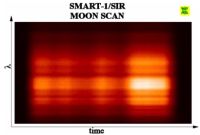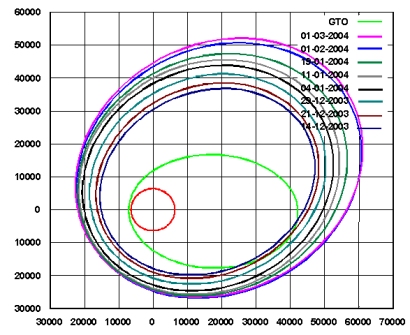No. 19 - Entering Eclipse Period
We are now approaching a season of long eclipses. This is due to the present alignment of the Sun, Earth and the line of apsides (line joining the apogee and the perigee). At launch the apogee point of the spacecraft's orbit was on the Sun side. Now, around six months on, the perigee point is on the Sun side and the apogee point is in the Earth shadow cone (umbra).
This is not necessarily a problem except for three further factors that come into effect at this time:
- The Earth is approaching the point of the vernal equinox in its orbit. At equinox the Sun is directly overhead a point on the Earth's equator at noon. This means that the shadow cast by the Earth into space is also in the plane of the equator.
- The inclination of the SMART-1 orbit with respect to the equator is just under 7 degrees.
- The velocity of the spacecraft at apogee is only 1.67 kms-1, compared to 5.43 kms-1 at perigee.
The combination of these three factors means the spacecraft will travel at its slowest through a relatively large umbra region. When the spacecraft is in the umbra it cannot receive power to its solar panels.
The orbital period is now about 25 hours, therefore the eclipses will repeat every day with a one hour shift per day. A total of 20 eclipses will occur starting on 1 March. The longest eclipse will start at 17:34 UTC on 13 March and will last for 2 hours and 8 minutes (2 hr 15 min considering also the penumbra). This will stress the power system and in particular the batteries to the maximum limit. The flight control team and the power specialists will be watching the spacecraft behaviour carefully during this period.
Update on Commissioning Activities
As covered in earlier status reports the previous few weeks have seen the commissioning of the spacecraft scientific payload. The last few days of commissioning were dedicated to the camera AMIE, the transponder KaTE, to the imaging X-ray spectrometer DCIXS and the solar X-rays monitor XSM.
SIR Scan of Moon
SIR infrared spectrometer

Has survived well the passage through the radiation belts and has obtained first light during a Moon scan.
AMIE
The AMIE camera performed the Laser Link experiment, which consisted in taking images of a laser beam sent from the Optical Ground Station in Tenerife, Spain. AMIE needed to calibrate its response by imaging various bright stars. This was done on the 15 February, with Vega, Arcturus and Theta Crater imaged through all filters.
KaTE
KaTE utilised the DSS13 Ground Station from Goldstone, NASA to carry out its tests of Ka and X band downlink as well as X band uplink. All experiments proved to be successful! The signals from KaTE have been received nominally on Earth and KaTE has been able to lock on to the carrier signal sent by the Ground Station. This great experiment, never performed before with a European spacecraft, shows not only that the transponder works perfectly, but also that the Flight Dynamics prediction were accurate enough for the Ground Station to be able to track SMART-1.
DCIXS and XSM
Internal calibrations took place after launch, but the doors protecting the sensors of both DCIXS and XSM opened for the first time on 19 February 2004. The spacecraft slewed to point DCIXS in the direction of the Crab Nebula, a standard candle for X-ray instrumentation. The background level was very high due to the solar activity. XSM performed an automatic annealing of its sensor, which shows that the automatic procedure to get a better signal works very well. XSM has been able to monitor X rays coming from the Sun and behaved as expected.
EPDP and SPEDE
The instruments dedicated to the plasma analysis performed their calibrations as planned and the results are very satisfying. This will allow scientisits to derive the history of the technical performance of the instruments.
Planned Spacecraft Activities
March 2004
- There will be a period of EP thrusting and long eclipses, which will limit the payload to simple operations at apogee. Only EPDP and SPEDE will be operated to monitor the Electric Propulsion effects on the spacecraft environment.
Orbital/Trajectory Information
The ESOC specialists periodically compute the osculating orbital elements. These elements define the so-called "osculating orbit" which would be travelled by the spacecraft if at that instant all perturbations, including EP thrust, would cease. Therefore, it is an image of the situation at that epoch. In reality, the path travelled by the spacecraft is a continuous spiral leading from one orbit to another. The most recent osculating elements are as follows:
|
EPOCH (UTC) 2004/03/01 00:40:52.7 Elements WRT Earth (J2000) |
|
| Pericentre Distance (km) |
20 683.544677 |
| Apocentre Distance (km) |
66 915.918535 |
| Semi Major Axis (km) |
43 799.731606 |
| Eccentricity |
0.527770 |
| Inclination (deg) |
6.979793 |
| Asc. Node (deg) |
149.196514 |
| Arg. of Pericentre (deg) |
213.620306 |
| True Anomaly (deg) |
180.018294 |
| Osc. Orbital Period (h) |
25.340528 |
Displayed in the plot are the osculating orbits at launch (GTO) and at different times throughout the mission. Since the start of the mission the electric propulsion engine has changed the orbital parameters as follows:
- Semi-major axis of the orbit increased by 19 170 km
- Perigee altitude from 656 km to 14 305 km
- Apogee altitude from 35 844 km to 60 537 km
- Orbital period from 10 hours 41 minutes to 25 hours and 20 minutes
 |
Contact Points
Giuseppe Racca
SMART-1 Project Manager
ESA/ESTEC - SCI-PD
Keplerlaan 1- 2200 AG Noordwijk, The Netherlands
E-mail: Giuseppe.Racca esa.int
esa.int
Bernard H. Foing
SMART-1 Project Scientist
ESA/ESTEC - SCI-SR
Keplerlaan 1- 2200 AG Noordwijk, The Netherlands
E-mail: Bernard.Foing esa.int
esa.int

